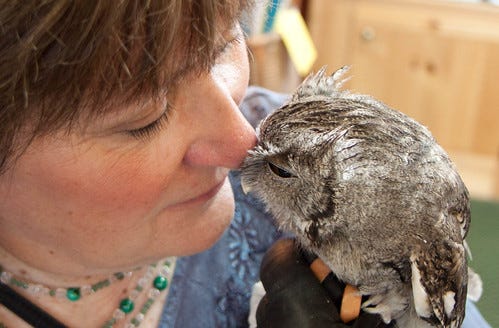(Listen to the radio version here.)
Most of us have a favorite author with whom we feel a real connection, as if the person behind words on a page could be a genuine kindred spirit. What a lovely fantasy that is! But imagine reading a rich and wonderful book, enjoying and nodding your head almost constantly—it’s all so good—as you dream about meeting the author. Then out of the blue, on page 133, you come across your own name—the author is quoting your work!
Back in 2016 when the New York Times bestseller The Genius of Birds was published, I was thrilled that a book about bird intelligence was getting so much attention. I didn’t rush out to buy it because new books are usually both beyond my means and my limited shelf space, but the more I heard about The Genius of Birds, the more it seemed worth the cost, so months after it came out, I bought a copy.
Most people writing about bird intelligence or emotions who strive for accuracy are so scared of being accused of anthropomorphism that they overcompensate, committing the opposite but equally egregious sin of what I call anthropocentrism, writing as if emotions and high intelligence are uniquely human characteristics outside the laws of evolution and natural selection. Jennifer Ackerman understands that a lot about what goes on inside bird brains is beyond our limited understanding, so she never puts an anthropomorphic interpretation on how birds behave and react in various situations, but she also doesn’t assume birds don’t feel emotions such as grief at the loss of a mate or offspring.
It was in a section about grief in The Genius of Birds that, what to my wondering eyes should appear but my own name, with a quote from a blog entry I’d written in 2012 titled “Scrub-Jay Funerals and Blue Jay Irish Wakes.” Clearly and literally, Jennifer Ackerman and I were on the same page!
When her next book, The Bird Way: A New Look at How Birds Talk, Work, Play, Parent, and Think, came out in 2020, her publishers sent me a digital copy before publication. I reviewed it and also got to enjoy a nice long Zoom conversation with Ackerman which I condensed into a week of podcast segments and blogposts.
June 13, 2023, was the release date of Jennifer Ackerman’s newest, What an Owl Knows: The New Science of the World's Most Enigmatic Birds. Like all her work, this book is extensively researched, beautifully written, and comprehensive. What an Owl Knows covers the gamut: the role owls play in art, culture, and the human imagination; how researchers study such secretive birds; their amazing vision and hearing; what we understand about their complex vocalizations; owl behavior including courtship, nesting, and migration; their intelligence; and what we can do to protect them. Ackerman manages to accurately explain complex concepts in her clear and engaging style such that even an interested fifth grader could understand complicated nuances of owl physiology and morphology.
I feel a little awkward reviewing this splendid book because Ackerman quotes me rather extensively in one chapter, “An Owl in the Hand: Learning from Captive Birds,” regarding my education screech owl Archimedes, and also my online “Owls of Harry Potter,” in which I call myself “Professor McGonagowl.” (This section of the chapter was excerpted on Literary Hub this week.)
Mentioning me was ever so gratifying, but I’m far from the main focus of the chapter, which Ackerman starts with Greek mythology’s Athena and her sacred pet, Merlyn’s owl Archimedes in T. H. White’s The Sword in the Stone, and Harry Potter’s Hedwig, before she moves on to real life. It didn’t surprise me that Teddy Roosevelt had a Barn Owl among his childhood menagerie, but I didn’t know that Florence Nightingale had a pet owl named Athena, that Picasso had a pet owl he considered his muse, nor that the founder of The New York Herald, James Gordon Bennett Sr., collected live owls, a fascination that may have been sparked during the Civil War one night when he was at sea and a hooting owl awoke him in time to keep his boat from running aground.
The meat of this chapter is about owl experts studying captive owls, including Minnesota’s own Gail Buhl of The Raptor Center and Karla Bloem, founder of the International Owl Center in Houston County, and her famous Great Horned Owl Alice.
Ackerman interviewed a host of experts who’ve lived or worked with captive owls, and she writes about the fascinating insights these authorities have made regarding owl sensory capacity, behaviors, vocalizations, intelligence, and emotions, and also about the lovely bonds forged between many of these researchers and their avian subjects. And this is just one of nine chapters!
What an Owl Knows is chock-full of interesting facts, some new to me, such as how researchers detect REM patterns in sleeping barn owls. The most mind-blowing factoid for me was about how owls process sounds in the visual center of their brains, their pupils dilating when they hear a noise. This was interesting enough, but this research led to the development of hearing tests for newborn babies. When my grandson Walter was born, I wondered how they could possibly test his hearing while he was still in the hospital—he sure wasn’t able to press a button when he heard a tone! But thanks to owl research, doctors now detect babies’ responses to sounds by watching their pupils.
I received my reviewer’s copy of What an Owl Knows free from the publisher, but even if I hadn’t been mentioned in it, this is a book I happily would have paid full price for even before I read it, knowing how wonderful Jennifer Ackerman’s other bird books are. I quickly finished reading it but doubt if I’ll ever be done referring to it—What an Owl Knows is so rich in useful information that I’ll keeping it within easy reach from now on.








